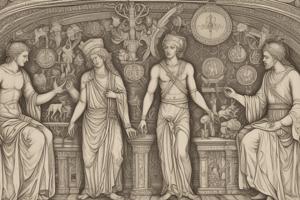Podcast
Questions and Answers
Which practice reflects the approach to illness prevalent during the Middle Ages, as described in the material?
Which practice reflects the approach to illness prevalent during the Middle Ages, as described in the material?
- Applying antiseptic techniques during surgery
- Administering vaccinations preventatively
- Performing bloodletting as a form of treatment (correct)
- Using X-rays for diagnosis
How did Andreas Vesalius contribute to the field of anatomy during his time?
How did Andreas Vesalius contribute to the field of anatomy during his time?
- By discovering the circulation of blood.
- By developing the first vaccines for common diseases.
- By pioneering the use of anesthetics in surgery.
- By demonstrating anatomical differences between humans and animals. (correct)
What fundamental concept did William Harvey introduce to the understanding of human physiology?
What fundamental concept did William Harvey introduce to the understanding of human physiology?
- The use of antiseptics in surgery.
- The process of vaccination for disease prevention.
- The existence of different blood groups.
- The heart functions as a muscle. (correct)
What is a key characteristic of the Central Nervous System (CNS)?
What is a key characteristic of the Central Nervous System (CNS)?
What role did Louis Pasteur play in advancing medical practices?
What role did Louis Pasteur play in advancing medical practices?
How did the discovery of penicillin by Alexander Fleming impact healthcare during World War II?
How did the discovery of penicillin by Alexander Fleming impact healthcare during World War II?
How does Polio enter the body and affect the nervous system?
How does Polio enter the body and affect the nervous system?
If a patient advocates for a treatment plan that differs from conventional medical advice, how should a healthcare provider proceed, according to the principles discussed?
If a patient advocates for a treatment plan that differs from conventional medical advice, how should a healthcare provider proceed, according to the principles discussed?
Flashcards
Anatomy
Anatomy
The study of the structure of the body.
Egyptians
Egyptians
Ancient civilization known for embalming dead bodies.
Hippocrates
Hippocrates
"Father of Medicine"; emphasized observation and diagnosis.
Andreas Vesalius
Andreas Vesalius
Signup and view all the flashcards
William Harvey
William Harvey
Signup and view all the flashcards
Wilhem Rotgen
Wilhem Rotgen
Signup and view all the flashcards
Louis Pasteur
Louis Pasteur
Signup and view all the flashcards
Central Nervous System (CNS)
Central Nervous System (CNS)
Signup and view all the flashcards
Study Notes
- Most medical curriculums begin with Anatomy.
- Anatomy topics include:
- Gross Anatomy
- Neuroscience
- Histology (Cell Biology)
- Embryology
- Study tips:
- Try different methods to see what works best individually.
- Read before, during, and after class.
- Post test.
- Participate in group classes.
- Ask questions.
History of Anatomy
- Ancient civilizations had an interest in the human body.
- Egyptians embalmed dead bodies and believed sickness resulted from evil spirits.
- X-rays are used today.
- Hippocrates lived in 460 BC
- Generally regarded as the "Father of Medicine".
- The Hippocratic Oath involves doing no harm and respecting patient autonomy and dignity.
- Claudius Galens was another Greek Doctor.
- Associated with blood, phlegm, yellow bile, and red bile
The Middle Ages
- Illness was viewed as punishment by God in the eyes of the church.
- Astrology, destiny and sin were considered factors.
- Bloodletting, herbs, and potions were common treatments.
- Andreas Vesalius, 1543, demonstrated humans and animals have different anatomy.
- William Harvey, 1628, described how the heart works as a muscle.
- Wilhem Rotgen, 1896, discovered x-rays.
- Anesthetics were developed in the 1800s.
- Karl Landensteiner discovered the 4 blood groups in 1901.
Louis Pasteur
- Louis Pasteur discovered that good hygene and vaccinations were important.
Joseph Lister
- Joseph Lister was a surgeon.
- Regarded as the "Father of antiseptic surgery" in 1865.
Alexander Fleming
- Alexander Fleming discovered penicillin in 1928.
- Penicillin had a huge advantage in saving lives, specifically in WW2.
- Polio, Rubella, and Measles vaccinations existed in the 1950s and 1960s.
- Polio is transmitted via the fecal-oral route.
- It can either be naked or enveloped.
- It binds to the CD155 receptors on neurons on the cell surface.
- Poliomyelitis is the inflammation of the spinal cord.
Neuroscience Concepts
- Neuroscience is considered difficult.
- Nervous system components:
- The central nervous system (CNS).
- The Brain and spinal cord.
- The CNS develops from a neural tube.
- All of it is connected!
- Peripheral nervous systems connect to Cranial and spinal nerves
- These come from the CNS
- Nerves can be affected by developmental problems and injuries.
Embryology
- How is the brain is made during fetal development?
- Gastrulation is the formation of three tissue layers from which all organs and tissues are derived.
- Most organ systems contain two of the three germ layers:
- Ectoderm
- Mesoderm
- Endoderm -Neurulation is the process that creates the primary germ layers.
- The Notochord forms the embryonic central axis.
- It also induces neural plate formation.
- The spine degenerates to nucleus pulposus.
- Somite (Paraxial mesoderm).
- Sclerotome (bone and cartilage).
- Myotome (skeletal muscle).
- Dermatome (dermis).
Studying That Suits You
Use AI to generate personalized quizzes and flashcards to suit your learning preferences.




